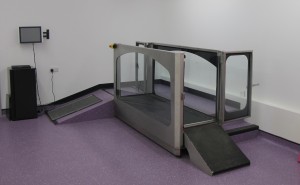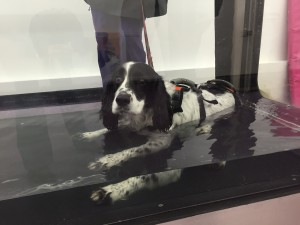Hydrotherapy has long been known to have many benefits in exercise and rehabilitation. The benefits of being immersed in and moving through water are well documented and are related to:
- Hydrostatic pressure – the pressure of the water on the limbs and joints improves circulation and reduces swelling. It also has a direct action on nerve receptors causing a reduction in pain.
- Resistance – the resistance of moving through the water helps to strengthen muscles, improve fitness and burn calories. Water is 15 times more viscous than air, thus requiring more effort to move through it. This viscosity also helps weak patients to stand and walk before they can do so without the presence of water.
- Buoyancy – as the depth of water increases, weight bearing decreases, and so the impact of weight on the joints is reduced. This is especially helpful for arthritic animals that are carrying a bit of extra weight.

Underwater treadmill used at Ark Vets
However, most dogs are not natural swimmers. They are designed to walk and run on land. the muscles needed for walking/running are different from those used to swim. Therefore the use of an underwater treadmill combines all the benefits of being immersed in water, but utilises the muscles that are needed to move on land. It also has the added benefit of being able to vary the speed that the dog moves at and the depth of the water, allowing us to target individual muscles and design a plan to suit the needs of each individual dog.
Underwater treadmill therapy has many indications, the most common of which are for
- Athletes, fly ball/agility to improve fitness and build muscle
- Acute injuries, strains/sprains to reduce swelling and pain and speed up a return to normal activity
- Chronic arthritis to maintain muscle bulk and functional use and reduce pain
- Post surgery to get a faster and more complete return to function
- Weight reduction allowing overweight animals to safely exercise and burn calories
The water is supplied to the treadmill from a large holding tank where it is kept at 30 degrees celsius. It is continually filtered to ensure it is kept clean, and regularly changed.

Relaxing in treadmill before exercise
When a dog is introduced to the treadmill, we walk them through it a few times to ensure it is not scarey. Once they appear comfortable we then close the doors. Then we start to fill it with water, and the water enters from under the moving belt. The height of the water used, will be dictated by the condition/injury that we are treating. Using lower levels encourages the dog to pick their feet up, increasing the flexion of all the joints. Higher levels give more buoyancy without altering the gait, and so support the dog as they build up their strength. Often we will use a combination of different heights of water during the workout to get maximum benefit.
Here is Max walking with low and high water levels
We also control the speed that the belt moves at. It can go from 0.5 to 6 miles per hour. We start at a slow comfortable walking speed and as the dog’s condition improves we can move them up to a trot.
Initially the patient will start with several short sessions with a 2 minute break inbetween. The length of these will gradually increase up to athletes who can happily do 25 minutes at a fast walk.
Video is used to record the animal walking on the treadmill, so allow the walking movement to be analysed by the vet, and now we can record them in slow motion to even more accurate analysis. Here is Max in slow motion
Although the underwater treadmill is used mainly for dogs, it is not exclusive and cats can also benefit greatly from its use – see some proof in cat in the underwater treadmill.